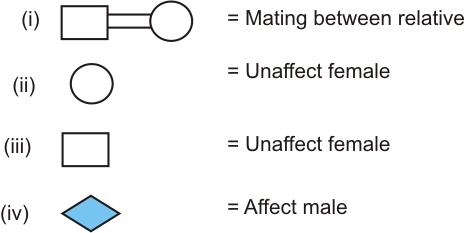JSS University Mysore 2025
NAAC A+ Accredited| Ranked #24 in University Category by NIRF | Applications open for multiple UG & PG Programs
Pedigree Analysis is considered one of the most asked concept.
21 Questions around this concept.
In the following human pedigree, the filled symbols represent the affected individuals. Identify the type of given pedigree.

Which one of the following symbols and its representation, used in human pedigree analysis is correct?
Observe the given pedigree and choose the appropriate statements:

1. The pedigree shows inheritance of X-linked recessive disorder.
2. The genotype of II-4 is
3. Hemophilia can be an example of this type of inheritance
4. Individual 14 could be a carrier for the disease
Study the pedigree chart and determine the mode of inheritance :

Study the pedigree chart of a certain family given below and select the correct conclusion which can be drawn for the character

Which one of the following symbol set and its representation, used in the human pedigree analysis is correct?
If a colour-blind female marries a man whose mother was also colour-blind, what are the chances of her progeny having colour-blindness?
NAAC A+ Accredited| Ranked #24 in University Category by NIRF | Applications open for multiple UG & PG Programs
Select the incorrect statement regarding pedigree analysis:
Tick the correct option with respect to Principles of Inheritance & Variation.
_________ experiments showed that the “factors” that we now know as “genes”, are the factors which are responsible for the inheritance of traits from parents to offspring.

Types of genetic disorders to be analyzed using pedigree charts:
"Stay in the loop. Receive exam news, study resources, and expert advice!"
